In the Flesh: 2016 Honda RC213V-S Up Close
It's a nice bike, but the speed of light only costs $2000-per-second more
What can I add to what’s already been said about the new “MotoGP bike for the street” Honda unveiled yesterday? When I asked Large Project Leader Yosuke Hasegawa if he thought $184,000 was too expensive or too cheap, he didn’t think long before answering that the bike is way too inexpensive at that price. The joke is his hair was dark when he started on the project three years ago; now it’s white.
Right, the U.S. version is rated at 101 horsepower, and the Japanese model even less. Basically, American Honda’s being penalized for playing by the rules. While many other manufacturers certify their bikes meet the 80 dB U.S. sound requirement, Hondas actually do meet it – and so will the RC213V-S. Since it was designed as a racebike, though, there’s just no room for the big muffler and sound-quelling airbox adornments you’ll find on something like the CBR1000RR. Standing trackside at a recent “comparo,” one of Honda’s PR guys says when the CBR comes past, “its chain slap is the loudest noise it makes.” I’ve observed the same thing. The CBR isn’t quite that quiet, but certain bikes from Europe are in a different league of sound production when they’re at full throttle.
With its rear cylinder bank tucked between the rider’s knees and its CFRP (carbon fiber reinforced plastic) subframe, Honda touts unparalleled mass centralization, and adopted “maneuverability” as its official number-one goal and target met with the new RC. The panel of engineers on display seemed slightly baffled as to why people would be so upset by a triviality like the official horsepower number? Getting the full ration is a simple matter of swapping a few pre-existing components lying around on the shelves at Honda. Parts distribution elsewhere isn’t their problem. Maybe the sportbike world doesn’t revolve around the U.S. anymore?
Honda justifies the price of the RC by pointing out that this is not a GP replica, but an actual GP bike built by the same specially trained people, in the same shop, who really do build the race machines – complete with all that bike’s hand-torqued titanium fasteners, hand-built fuel tank, hand-TIG-welded frame, carbon-fiber bodywork and exquisite components. Nearly all the parts are same-same as the race machine. It’s an extraordinary amount of money for a motorcycle, but not at all for a piece of art in the current economic climate, and motorcycle art is really exactly what the Honda is; maybe not so much a work of art as a really nice assemblage of a bunch of works of art in its own little rolling museum. I’d rather have it in my living room than a Picasso. You?
The guys I occasionally talk to who own exotic things like this seem to enjoy telling the tale of who they know, what strings they pulled to obtain their rare machines. To them, stalking the “you’re-not-allowed-to-have-that!” race kit that unlocks the RC213V-S’s true 212-hp potential will only add to the appeal. (And if they can’t get that, a Dynojet Power Commander or similar and a call to Akrapovic will probably achieve a similar result for a lot less money than the 12,000-euro Honda kit, but a lot less fun.) On the other hand, the Honda kit also includes a ram air duct to replace the headlight, a reverse-pattern shift drum, a load-cell-type five-way adjustable quickshifter, data-logging system, an adjustable-length rear shock linkage, and a few other tidbits that might not be so easy to forge.
What you get for that money really is a MotoGP bike for the street, as Honda keeps insisting, though more like the RC1000V than the RC213V, since it has steel valve springs instead of pneumatics and a standard six-speed gearbox instead of the 213’s seamless one.
The 999cc V-Four, however much power it makes, has a 10-gear system to drive its two banks of double-overhead camshafts and their titanium valves, with its water pump driven off one of the front cams for compact efficiency. Connecting rods are titanium, and carry 13:1 pistons, now with three rings for road-going emissions requirements. The exhaust system has a power valve and a catalyzer in each of its banks to keep things down to a dull roar, but once uncorked, the bike’s 360-degree crank will no doubt make plenty of that noise that got us hooked in the first place. None of the bikes at the press launch were started, much less ridden. (I looked for the key but there isn’t one.) Which is a shame, because we’ve had some good times in the past at the crazy-fast Circuit Catalunya, riding Hayabusas and things. (And more than one bad time, too… maybe Honda did the right thing in not allowing certain of us to ride an $184K bike around on it?)
Anyway, Honda goes to the extra V-Four expense, according to engineering chief Tetsuya Suzuki, mostly because that configuration provides the best rear-tire traction in the tightest package. Yamaha gets there with its crossplane inline-Four, but only by resorting to the heavier, less elegant solution of a 90-degree crankshaft. Honda says the dry RC in U.S. trim will weigh 379 pounds. With 4.3 gallons of fuel, that should equate to 40-some pounds lighter than a Yamaha R1M – around 10 percent lighter for 10 times the money. It’s true what they say; lightness is the most expensive part. (If the 418-lb. estimated “Curb” weight is the true one, the RC’s only 25 pounds lighter than the Yamaha.)
Natch, the new bike had to have electronic aids aplenty, and it does. But it doesn’t sound like they’re as intuitive or easy to use as the ones on the R1 or BMW S1000RR. There are three power levels: P1, P2 and P3 sound easy enough. P1 is full power, P3 sounds like a rain setting.
Honda Selectable Torque Control (HSTC) sounds like traction control in Hondaspeak, and is exactly that. The RC gets the fashionable IMU (Inertial Measurement Unit) all the cool literbikes now have, and works with it and wheel-speed sensors to keep you from applying too much torque to the rear contact patch and falling off; there are nine levels of TC available as well as Off. In addition to the bike’s mechanical slipper clutch, the dashboard also offers four levels of engine braking; there’s also an electronic quick shifter.
All this is displayed on a color TFT instrument panel like the one on the Ducati Panigale, though nobody switched it on to wow the crowd, or even projected a photo of how it would look on the ceiling of the geodesic dome tent where the RC Show (with your host Nick Harris and special guest stars Marc Marquez and Dani Pedrosa!) took place in the racetrack parking lot. Come to think of it, it is rather strange they brought us all the way to Barcelona and didn’t even fire an RC213V up, much less let us ride one. Very strange really. And yet, strange is the new normal.
Strangely absent also would be antilock braking: While the other manufacturers have already moved onto lean-sensitive ABS, the RC has no ABS at all. And I almost hesitate to reveal how soft and coddled I’ve become by stating it, but the BMW S1000RR has cruise control. On a ride-by-wire bike, why not? Especially a $184K one.
Honda says it will build one bike a day, beginning this September and ending at the end of 2016, with a total run of about 200 machines which will be instantly collectible by people all around the world who are bored with their MiG fighter jets and Desmosedicis. For them, $184,000 isn’t any kind of a stretch at all. Spending big money brings them happiness.
For the peasantry who’ve been impatiently waiting for a real V-Four powered literbike from Honda ever since way before Nick Hayden won the 2006 MotoGP championship on one (okay it was a V-Five), and right through the socks-again-for-Christmas VFR1200 and the neck-tie Interceptor, well, we get to keep on waiting. In its defense, Honda points out it has built a slew of great beginner bikes and really practical ones lately, which is entirely true but somehow fails to ease our angst.
The longer you hang around, the more amusing it is to watch history keep repeating: When the long-rumored RC45 got here 21 years ago, $27,000 was a crazy amount of money, and some sort of flapper valve issue in its intake to keep the noise down meant it didn’t make nearly as much power as the pedestrian 750s of the masses. Now, people want twice $27k for a nice RC45, while most ZX-7s and GSX-R750s of that era have passed on to their reward. Equally entertaining is that our Honda PR guys report that they just discovered four RC45s, still in their crates, squirreled away in the warehouse at Honda HQ in Torrance.
As for the new RC, it’s an excellent time to adopt toward it the attitude of my friends on the right side of the political spectrum: If you want one, quit bitchin’ about the price and work harder. If you don’t like our laws in America and 101 hp isn’t good enough for you, move to Europe with the socialists! It’s not a bad idea. I’ve finally mastered the bidet. As for me, I’m a firm believer in buying used. Maybe Honda will swing me a deal on the moldy RC45 with the rat-bitten wiring harness? I’ll hold off a bit on the 213.
If you can’t wait (and Honda knows you’re out there!), reservations are being taken exclusively through the official website: www.RC213V-S.com beginning at 3:00 p.m. PST on July 12, 2015, where Honda says it will “discuss business discussions in hospitable manner.” To me that sounds like you’ll be doing good to get one at list price. Do like Kevin Cameron advises and buy two, an A and a B. Then we can all go for a ride.
| RC213V | RC213V-S (US) | RC213V-S (Europe) | RC213V-S (Europe, with kit) | ||
|---|---|---|---|---|---|
| Overall length (mm) | 2,052 | 2,100 | 2,100 | 【2,100】 | |
| Overall width (mm) | 645 | 770 | 790 | 770 | |
| Overall height (mm) | 1,110 | 1,120 | 1,120 | 【1,120】 | |
| Wheelbase (mm) | 1,435 | 1,465 | 1,465 | 【1,465】 | |
| Minimum ground clearance (mm) | 115 | 120 | 120 | 【120】 | |
| Seat height (mm) | – | 830 | 830 | 【830】 | |
| Vehicle weight | 348 lb. | 379 lb. (dry) (Curb Est. 418lbs.) | 375 lb. (dry) | 353 lb. (dry) | |
| Maximum number of riders | 1 person | 1 person | 1 person | 1 person | |
| Minimum turn radius (m) | – | 3.7 | 3.7 | 6.4 | |
| Engine type | Liquid-cooled 4-stroke DOHC 4-valve V4 | Liquid-cooled 4-stroke DOHC 4-valve V4 | Liquid-cooled 4-stroke, DOHC 4-valve V4 | Liquid-cooled 4-stroke, DOHC 4-valve V4 | |
| Total displacement (cm3) | 999 | 999 | 999 | 999 | |
| Bore × Stroke (mm) | – | 81.0 × 48.5 | 81.0 × 48.5 | 81.0 × 48.5 | |
| Compression ratio | – | 13 | 13 | 13 | |
| Maximum power | Over 234 hp | 101 hp @ 8,000 rpm | 157 hp@ 11,000 rpm | 212 hp @ 13,000 rpm | |
| Maximum torque | – | 66 lb-ft. @ 8,000 rpm | 75 lb-ft. @ 10,500 rpm | 87 lb-ft. @ 10,500 rpm | |
| Fuel supply | – | PGM-FI (Programmed fuel injection system) | PGM-FI (Programmed fuel injection system) | PGM-FI (Programmed fuel injection system) | |
| Starter | – | Self | Self | Self | |
| Ignition | – | Full transistor, battery ignition | Full transistor, battery ignition | Full transistor, battery ignition | |
| Fuel tank capacity | 5.28 gal. | 4.3 gal. | 4.3 gal. | 4.3 gal. | |
| Clutch | – | Dry multi-plate, coil spring | Dry multi-plate, coil spring | Dry multi-plate, coil spring | |
| Transmission | – | Constant mesh, 6-speed return | Constant mesh, 6-speed return | Constant mesh, 6-speed return | |
| Transmission gear ratio | 1st | – | 2.125 | 2.125 | 2.125 |
| 2nd | – | 1.647 | 1.647 | 1.647 | |
| 3rd | – | 1.368 | 1.368 | 1.368 | |
| 4th | – | 1.217 | 1.217 | 1.217 | |
| 5th | – | 1.1 | 1.1 | 1.1 | |
| 6th | – | 1.032 | 1.032 | 1.032 | |
| Reduction gear ratio | – | 1.933/2.471 | 1.933/2.471 | 1.933/2.353~2.933 | |
| Caster angle (degrees) | – | 24.6 | 24.6 | 【24.6】 | |
| Trail (mm) | – | 105 | 105 | 【105】 | |
| Tire | Front | 16.5 | 120/70ZR17M/C | 120/70ZR17M/C | 120/70ZR17M/C |
| Rear | 16.5 | 190/55ZR17M/C | 190/55ZR17M/C | 190/55ZR17M/C | |
| Brake | Front | Hydraulic double disc (Carbon) | Hydraulic double disc (Steel) | Hydraulic double disc | Hydraulic double disc |
| Rear | Hydraulic disc | Hydraulic disc | Hydraulic disc | Hydraulic disc | |
| Suspension | Front | – | Telescopic | Telescopic | Telescopic |
| Rear | – | Pro-Link | Pro-Link | Pro-Link | |
| Frame | Diamond | Diamond | Diamond | Diamond | |
More by John Burns






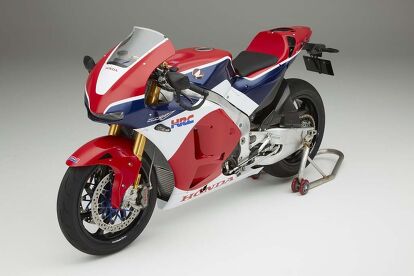









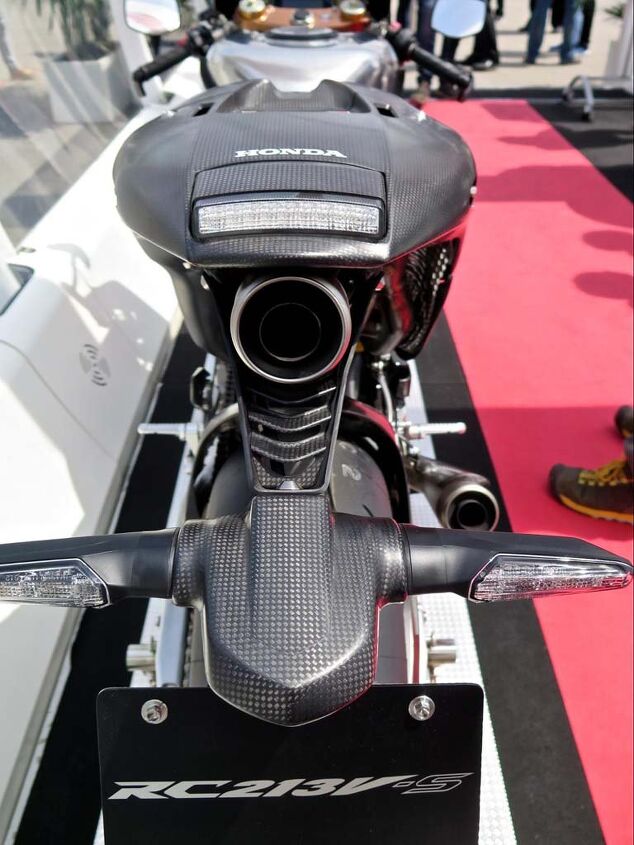




























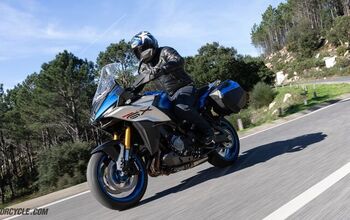
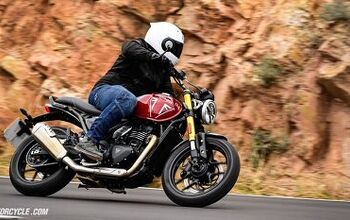





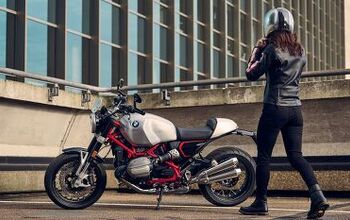


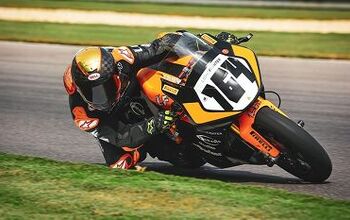




Comments
Join the conversation
Fine tolerance. I can only spec.ulate.
I think it'll be hard for them to sell the "exotic" nature of this bike with the Kawasaki supercharged bikes out there. This is what happens when 3 racers hang out in a bar for too long... "you know what would be fun?!?!? selling these bikes to regular people... They will love it! hic.." For this kind of money you can get a couple of truly unique bikes (Hazan, etc...).